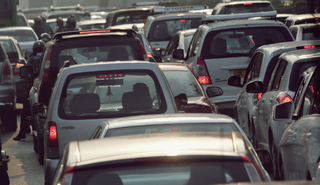Travel drop aided lockdown methane surge, study finds
24 November 2022

Sharp falls in transport emissions during Covid-19 lockdowns partly explain why a key greenhouse gas hit record high levels in 2020, research suggests.
More than half of the 50 per cent jump in methane’s growth rate between 2019 and 2020 was the result of reduced emissions from road transport, railways and planes during lockdowns, the study found.
Reduced transport emissions led to lower levels of another gas – called the hydroxyl radical – that acts like a detergent to remove methane from the atmosphere, researchers say.
Co-author William Collins, Professor of Climate Sciences at the University of Reading, said:
“Our research shows that reduced travel during the pandemic played a part in this surge as fewer cars on the road and planes in the sky meant less methane-cleaning gases in the atmosphere.
“But methane levels are still rising in 2022, meaning there is another factor behind the increase we have not established. We need to work out why this is happening and reverse the trend rapidly.”
Methane surge
Until now, the causes of the 2020 surge in methane – second only to carbon dioxide as a driver of climate change – had been unclear. Previous research suggested the rise might partly have been the result of increased natural emissions from tropical wetlands.
A team led by a University of Edinburgh scientist used global atmospheric chemistry models to study how lockdown emission changes affected methane levels. These rose by a record 15 parts per billion (ppb) in 2020 – up from 9.7 ppb in 2019. Previous studies estimate global nitrogen oxide, carbon monoxide and other transport-related emissions fell by 10-20 per cent in 2020.
The team’s findings suggest that, of the total 5.3 ppb rise in methane growth rate in 2020, reduced transport emissions led to a 2.9 ppb increase. Reductions in nitrogen oxides led to a 4.8 ppb increase that year, while reductions in carbon monoxide and other chemicals had the opposite effect, reducing methane growth by 1.9 ppb.
Around 30 per cent of the increase in methane in 2020 was caused by lower nitrogen oxide emissions from aviation, which fell by more than one fifth globally.
Further research into how the atmosphere’s make-up changed during lockdowns will help scientists better understand past methane changes and improve future projections, the team says.
COVID-19 lockdown emission reductions have the potential to explain over half of the coincident increase in global atmospheric methane, published in the journal Atmospheric Chemistry and Physics, was supported by the Natural Environment Research Council and the Royal Society. It also involved researchers from the University of Edinburgh and Lancaster University.
Stevenson, D. S., Derwent, R. G., Wild, O., and Collins, W. J.: COVID-19 lockdown emission reductions have the potential to explain over half of the coincident increase in global atmospheric methane, Atmos. Chem. Phys., 22, 14243–14252, https://doi.org/10.5194/acp-22-14243-2022, 2022.

